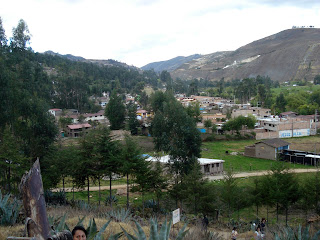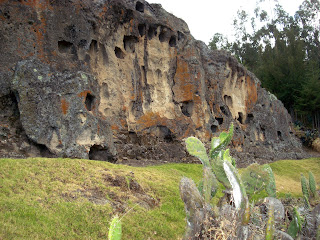The people who lived in this region of the northern highlands of Peru for milenia are referred to historically as the Cajamarca culture. The Wari conquered this area about two thousand years ago and made Cajamarca one of their many administrative centers, connecting by road with the Wari capital in Ayacucho. The Inca conquered the region in 1460 AD, connecting their capital in Cuzco with Quito, Ecuador. The Spanish, led by Francisco Pizarro, took over in 1540.
The Ventanillas (“little windows”)
of Otuzco is a large stone outcropping that was used for burials. This huge
necropolis consists of 337 graves sculpted in the rock, superimposed one on top
of the other and protected against the rain with narrow channels.
The niches have been looted long ago. It seems that the elite were first interred in the ground. The body was then exhumed, and the cleaned bones were placed in a niche, which was then sealed.
Most niches appear rather shallow, with room for the bones only. Others are reported to contain galleries of graves that extend 33 feet into the rock. A few (as in the center of the photo) were not completed, and are shallow depressions in the rock.
The reddish color is the lichens growing on the rock.
This ragtag group of boys entertained us with a typical Andean folksong. A short video is available here.
This is typical construction in the area. The adobe bricks are made from the local soil. The layers are separated by stones, allowing air to flow.
After visiting the Ventanillas, our tour group stopped at the Jardín de Hortensias (hydrangea gardens) to see the flower gardens, sample some local food and drink, and to buy handicrafts. Click here to see photos of the gardens with text in Spanish.
Food is available for purchase, such as fried pork (chicharrones) and corn tamales (humitas)
Cuy (guinea pig in English) was domesticated thousands of years ago in the Andes mountains in the region of Ecuador, Bolivia and Peru. They are commonly found in households as pets and as a food source. They are herbivores, living off kitchen scraps, and are part of the Andean diet. They contain high amounts of omega 3, low in fat, and high in proteins.
Fried cuy (courtesy Wikipedia)












No comments:
Post a Comment